#1930s home furnishings
Explore tagged Tumblr posts
Text
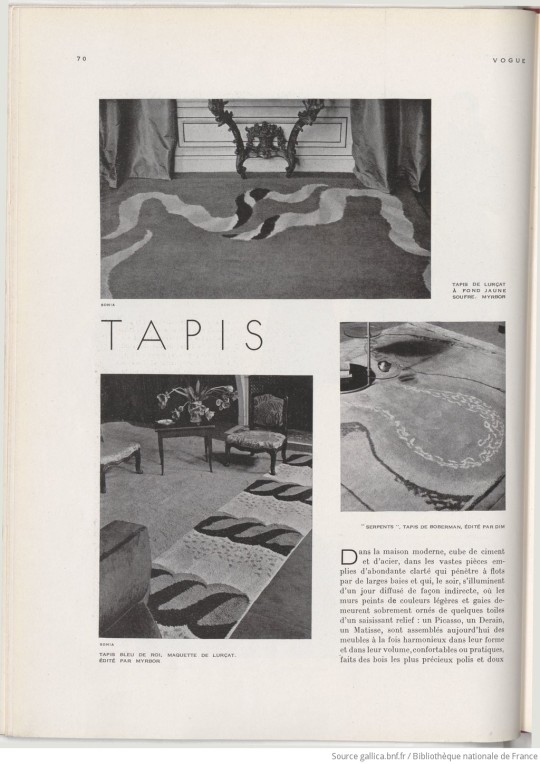
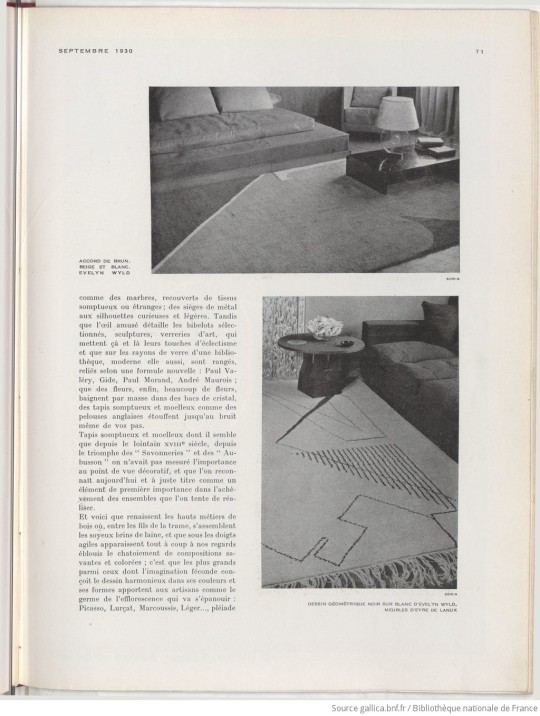


Carpet designs by Ivan Da Silva Bruhns, Jean Lurçat, Evelyn Wyld and Victor Boberman in the September 1930 French Vogue.
(source: Gallica)
#1930s design#1930s home furnishings#textile design#carpet design#rug design#1930s interior design#french vogue#art deco#ivan da silva bruhns#jean lurçat#victor boberman#evelyn wyld
5 notes
·
View notes
Text

Adorable, colorful 1930 home in Bluffton, SC has 2bds, 1ba, $549K. And, it's being sold fully furnished!

Look at the lovely street it's on. It's actually a beach house, b/c it's near Bluffton Beach, and you can use a golf cart to get around.


Enter thru the huge front porch. This is like a studio apt. itself.


It's so cheery and bright. I love the peach couch!


The kitchen is adorable. It has blue appliances!

Bedroom #1- the original door is painted peach.


There's an armoire and a pretty, mint green night stand. I love when nice furniture is included.



Big beachy bath has a beautiful sink and blue tile. This is so nice.



The 2nd bedroom features a cute trundle bed and a blue dresser.


I think that's a driveway behind the house, with a place to park the cars, but the yard is big enough to have potential for a patio.

The house is very close to the May River. 3,802 sq ft lot


I can't believe there's no HOA fee. There' a lovely park by the river.
https://www.zillow.com/homedetails/39-Oyster-St-Bluffton-SC-29910/68797762_zpid/?
#beach houses#lake houses#fully furnished homes#cottages#colorful homes#houses#house tours#home tour
163 notes
·
View notes
Text
CHAUMET ART DECO DIAMOND TIARA
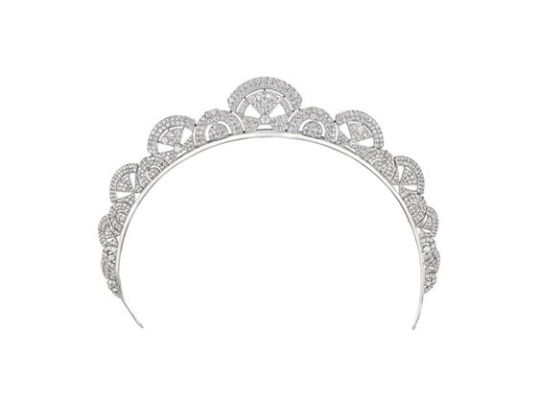
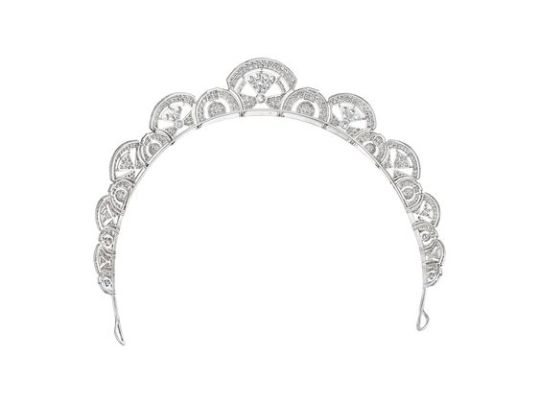
"Property from the Collection of Margaret Thompson Biddle
CHAUMET ART DECO DIAMOND TIARA Old-cut diamonds, platinum (French marks), circa 1930, maker's mark.
Margaret Thompson Biddle was born in Helena, Montana in 1896. She was the daughter of notable copper miner and financier, William Boyce Thompson.
Margaret’s father was born and raised around mining in Montana, so it was no surprise that he went on to make a name for himself in the copper mining industry. He attended the prestigious Philips Exeter Academy in New Hampshire, and Columbia University. After retiring from the New York Stock Exchange around 1915, Thompson’s interests returned back to mining where he founded the Newmont Mining Corporation.
Margaret Thompson married Anthony Drexel Biddle Jr. in 1931. That year he was also appointed the Minister to Norway by President Roosevelt, and then Ambassador to Poland 1937. This role led Biddle and his family all over the world. After fleeing Poland in 1939, they landed in England for one of Anthony’s commissions. In this position, he worked with the governments-in-exile of Belgium, Czechoslovakia, Luxembourg, the Netherlands, Norway, Poland and Yugoslavia. Biddle held numerous ambassador positions in the years that followed before re-enlisting in the army in 1944.
Margaret relocated to France after she and Anthony separated at the end of World War II. She had a home on the French Riviera, and a spectacular hotel particulier on the notable boulevard St. Germain in Paris. Not only was she a writer and author of The Women of England, Margaret was also known to be quite the hostess and socialite. One could find the Eisenhowers, the Duke and Duchess of Windsor, and many other notable French creatives at her soirees.
In addition to having a wonderful jewelry collection, Margaret was an avid collector of fine porcelain, silver, home furnishings and art by the most distinguished artists and makers. She gifted a 1,575 piece dinnerware service to former First Lady Eisenhower. Select pieces of the ‘Vermeil’ collection are still on display at The White House present day."
- Christies
#tiara#tiaras#diadem#diadems#hair piece#hairpiece#headpiece#head piece#head ornament#headornament#hair ornament#hairornament#diamond#diamonds#platinum#chaumet#christies#christie's#tiaras crowns#tiarascrowns#tiara crown#tiaracrown
59 notes
·
View notes
Note
Hc that Nico and Hazel like wearing clothes and listening to music from their childhoods together because it gives them a sense of comfort, a sense of familiarity, a sense of ‘I’m home, after all this pain I’m home again’
Oh totally! I love the headcanon that Nico and Hazel both listen to a lot of swing music and sometimes dance together, just cause it's comforting and nice to them to be reminded that they're not alone, and that there's someone around who remembers the 1930s too.
One of my big headcanons for the death sibs actually is that when Nico renovates Cabin 13, he leans a lot into vintage and 1930s-esque decor and furnishing. Basically he tries to recreate something similar to what he and Hazel grew up with, because it's their space! And they have the freedom to do whatever they want! They might as well make it what's comforting to them and is their idea of home.
So the inside of Cabin 13 has like, colorful walls and patterned wallpaper and lots of old photos everywhere and dark wood, etc etc. You know they have a gramophone in there somewhere. And when others visit it's simultaneously "Oh, huh, I expected something more... goth" and "Actually somehow yeah this feels expected and correct." It's a little Addams family-esque but with slightly more color. That's the vibe in my brain.
178 notes
·
View notes
Text

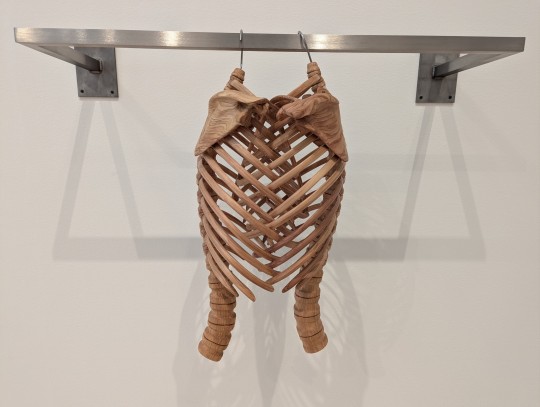

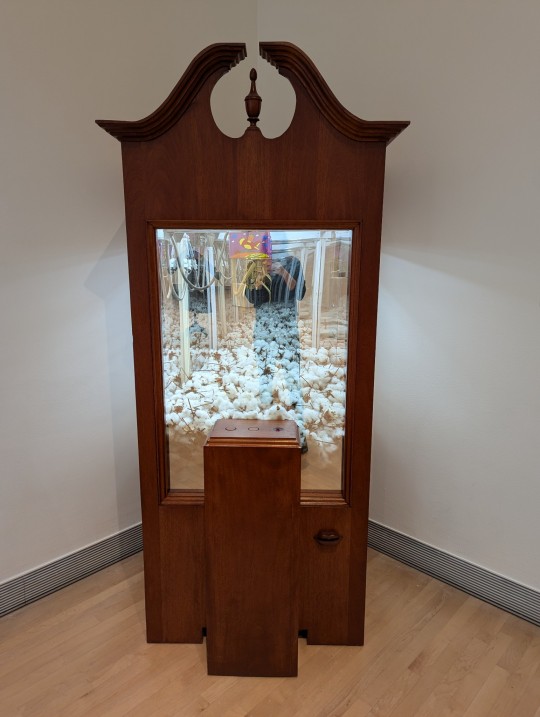
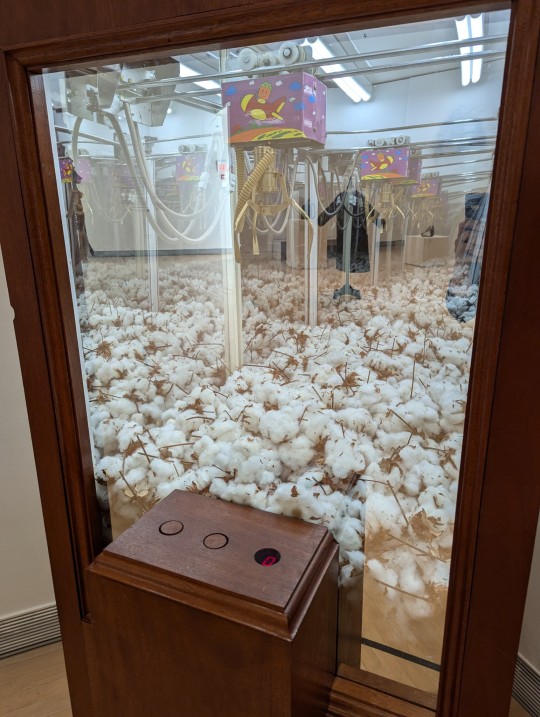

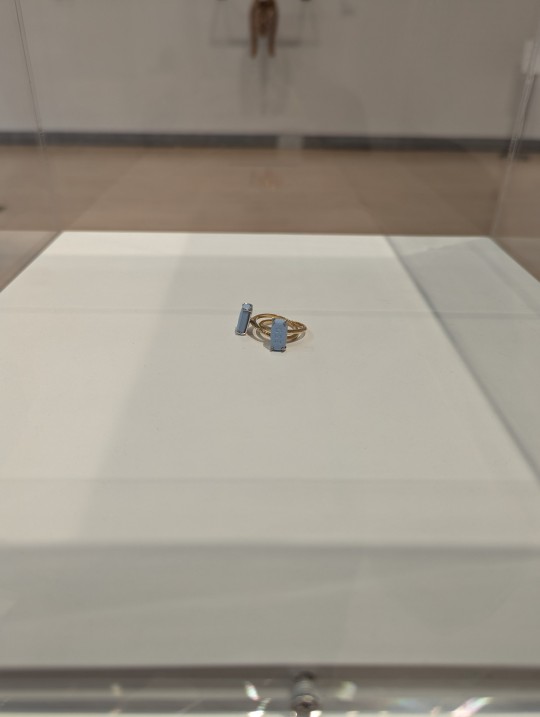
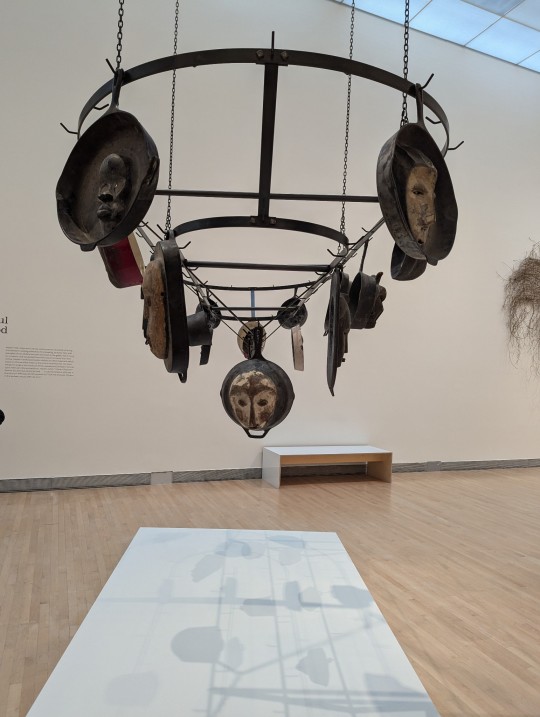
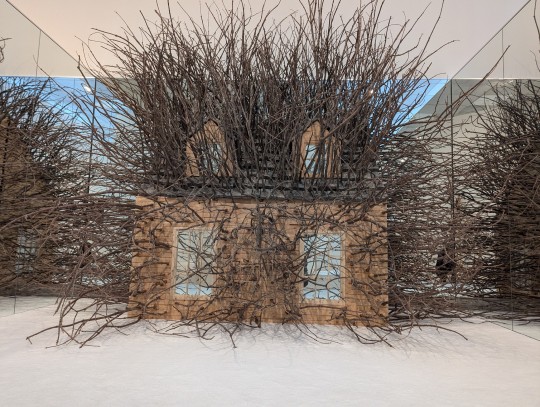
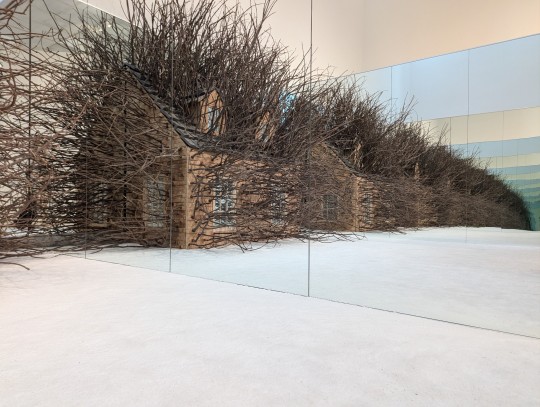
Photos of Hugh Hayden's Exhibition Home Work, as seen at the Rose Art Museum (Brandeis University), 2024. Throughout this post, text present in the gallery (written by museum curators, not me) is intended in block quotes.
Through his prodigious studio practice, Hugh Hayden (b. 1983, Dallas, TX) has become one of the leading artists of his generation. His meticulously crafted sculptures, hybrid forms, and poignant installations evoke profound reflections on the human condition within a complex, volatile, and often threatening world. hayden combines a probing analysis of serious and often painful topics with humor, visual puns, and wordplay, provoking a unique blend of visceral and critical responses.
I was captivated by Hayden's work from the moment I stepped into the gallery. Really stunning stuff. Names of all pieces in this post (left to right, top to bottom), as well as excerpts from gallery text, can be found below the Read More. I highly encourage you to check it out in more detail!
American Gothic (2024)
Hayden merges two skeletal figures with agricultural and domestic tools, examining aspects pertaining to labor and the dignity of work. The artist deliberately positions himself as part of a genealogy of American artists, referencing Grant Wood's 1930 painting American Gothic and Gordon Parks's 1942 photograph, American Gothic.
Eden (2022)
Eden presents two ribcages locked together in an intimate embrace. Hanging on a clothes rack, the ribcages are meticulously crafted from cedar wood, a material often used where clothes are stored to repel moths. The fact that the skeletal lovers are closeted suggests that this embrace needs to be kept a secret. The title references the bliss associated with the biblical Garden of Eden.
Hangers (2018)
High Cotton (2015-2020)
High Cotton, emulating and arcade claw machine, is clad in lustrous, Chippendale-inspired Honduran mahogany, carved to the recall the eighteenth- and nineteenth-century furnishings of high society. Sharp-edged cotton balls (replacing the game's expected toys) force a player to "pick cotton," a task directly associated with slavery. The work highlights the raw material used to produce the fine cotton clothing found around the world--and once neatly folded inside the mahogany armoires of slave owners.
Fairy Tale (2023)
Fairy Tale features a pair of interlocking Tiffany rings, with HIV-prevention medication replacing the expected diamonds or gems. The title suggests a "happily-ever-after" gay love story for those who once lived in the shadow of AIDS. The word "fairy" in the title, sometimes used as a slur, is here reclaimed with pride.
The Kiss (2020)
In The Kiss, two football helmets are caught together like stags whose horns are locked in battle. Their interlocking forms and the title of the piece suggest a range of relationships, from homosocial camaraderie to same-sex intimacy. Many of Hayden's sports-related sculptures expose the fact that the very devices supposed to protect may also wound. The Kiss recalls the high number of brain injuries suffered by football players.
Positives (2019-2024)
Hedges (2019)
This installation features a model of an archetypal suburban home. Rather than associating the domestic with security, Hayden transforms the familiar abode into an unsettling place where menacing branches sprout from and overpower the structure's walls, window, and roof. Hedges is experienced within a mirrored chamber that situates the viewer amid an endless row of uncanny houses. Hayden often notes that home ownership is considered one of the key goals of achieving the American dream. Yet this path is hardly assured for many people, given the inequities in society and the financial precarity that so many endure. As shown here and throughout the exhibition, Hayden's visceral sculptures reveal the disquieting contradictions of the American dream.
38 notes
·
View notes
Text
“By 1930, 40 percent of white and black working women were wives, one-third with children under age 13, but they still constituted only 11.7 percent of all wives. Several states banned married women from holding government jobs. Though the percentage of married women teachers doubled, the majority of school boards refused to hire them. Many people were worried about what it would mean to have wives work outside the home. What concerned them most was what it would mean to have white married women working outside the home.
Black women had long been forced by economic necessity to work for wages, and among agricultural worker families, 60 percent of Chicanas with children worked in the fields. Japanese immigrant women had been partners in their husbands’ businesses, domestic servants in other people’s homes, and agricultural laborers ever since their arrival in large numbers between 1907 and 1921. Married Puerto Rican women in New York City contracted with textile manufacturers to make garments, fine lace, and other goods in their homes. The press and policymakers had never worried about what those women’s work would do to their families. It was only when non-Hispanic, white native-born or even immigrant married women began to work outside the home in larger numbers that the issue became a public one.
…At the turn of century, young working women had most often lived at home or as boarders with other families. Now, between school and marriage they lived in their own apartments. They often shared these apartments with other young working women. Having their own apartments gave them a sense of autonomy, of young adulthood, of being unsupervised and unrestrained. It gave their parents a lot of worry. At the same time, young working women hardly lived in the lap of luxury. At $15 a week, their wages supported only tiny, often ill-lit apartments with sparse furnishings. For women doing dull work and living in ding, dark apartments on boring, cheap food, the phone company’s lounge and benefits gave them as close a glimpse as they might ever have of the middle-class life many wanted.
Whenever they sought more from life, to take in the new movies or go to amusement parks, or have a decent dinner, they had to find a man, who was better paid, to treat them. Young working women had started dating men to whom they had not been introduced, without supervision, almost a generation earlier. By the 1920s, this practice was widespread. Lounges, theater tickets, and lunches formed part of the new strategies by which large corporations had responded to the massive number of strikes in 1919. Many adopted something called the American Plan of corporate welfare. Instead of paying higher wages, companies provided increased benefits to workers.
…Although clerical workers and businesswomen were newly conspicuous among women workers in the 1920s, most women workers remained in the occupations that they had in previous decades: domestic service, agricultural labor, and certain manufacturing jobs. For a small subset of the middle and upper classes, work could be seen as inherently satisfying and liberating. For most working women, however, wage labor was a matter of necessity. In the 1920s, despite its reputation as an era of prosperity, 71 percent of U.S. workers earned less than the wage required to support what the government defined as the minimum acceptable standard of living for their families. As a result, in low-income families, 25 percent of all married women worked for wages.
In 1920, five times more married black women than women of any other racial or ethnic group worked outside the home. More than 50 percent of adult black women earned wages. In rural areas most performed back-breaking labor in the fields. In the cities most performed domestic service or laundering. Only 5.5 percent were able to gain employment in manufacturing, a better-paid sector, by 1930. As the total number of servants declined, black women became a larger and larger share of those remaining.”
- Sarah Jane Deutsch, “Women’s Work.” in From Ballots to Breadlines: American Women, 1920-1940
#sarah jane deutsch#american#1920s#1930s#race#gender#history#20th century#from ballots to breadlines
11 notes
·
View notes
Photo

Yew Tree Farm, Cumbria, England, Yew Tree, built in 1690, was owned by Beatrix Potter in the 1930s and is still home to many of her furnishings.
65 notes
·
View notes
Text
Radio aimed at homemakers:
Although broadcast radio was barely a decade old, its signals already covered a broad swath of rural America. Broadcasters soon discovered that they had a captive audience in the multitudes of farm women who were occupied with daily chores at home while their husbands worked in the fields. Big food manufacturers began to sponsor homemaking shows, usually heavy on recipes and running in the morning hours (the precursor to daytime television).
The fictional character of Betty Crocker was invented by one of the flour companies that later became part of General Mills. In 1924, “Betty Crocker” debuted as the narrator of a radio cooking school show, running twice a week at 10:30 a.m.; by 1930 it was heard over forty-three stations nationwide.
Not to be outdone, in 1926 the U.S. Department of Agriculture’s farm radio service debuted a five-day-a-week show called Housekeepers’ Chat hosted by “Aunt Sammy” (presumably some sort of consort to Uncle Sam). On the show, Aunt Sammy sat at the center of a large, somewhat inept family who regularly came to her with questions on everything from how to prepare a Thanksgiving pie to why children needed sunbaths. In reality, she was a folksy vehicle for the USDA’s Bureau of Home Economics to disseminate its expert advice on “nutrition, meal-planning, cooking, clothing, health, house furnishing, gardening, and other kindred subjects.”
From A Square Meal by Jane Ziegelman and Andrew Coe
3 notes
·
View notes
Text
Living the Hollywood Dream: Art Deco Elegance in Interiors
Maybe art deco style might work well for your house design if you fantasize about the glamorous Hollywood lifestyle of the 1920s and 1930s. But how does art deco decorating get its look? This dramatic, opulent vintage best home interior designer in Bhubaneswar can be achieved by recognizing design aspects and themes and applying them into the materials, furnishings, and decorating. The exotic…

View On WordPress
4 notes
·
View notes
Text
July 7 2022 Asheville NC and Denver CO
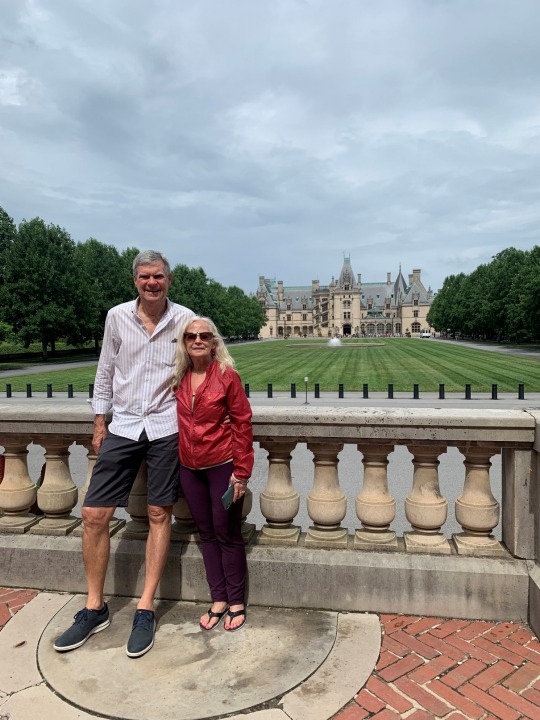
We visited The Biltmore Estate this morning, which is a major tourist attraction and resort in Asheville. According to Wikipedia
“Biltmore House (or Biltmore Mansion), the main residence, is a Châteauesque-style mansion built for George Washington Vanderbilt II between 1889 and 1895 and is the largest privately owned house in the United States. Still owned by George Vanderbilt's descendants, it remains one of the most prominent examples of Gilded Age mansions.
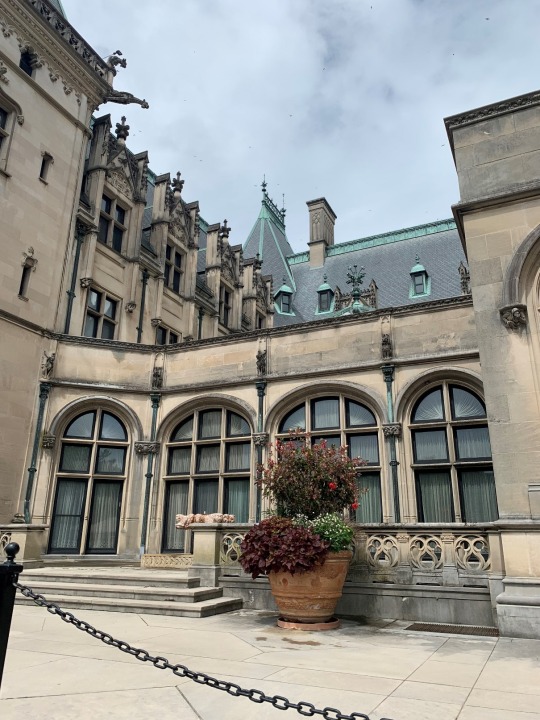
In the 1880s... George Washington Vanderbilt II began to make regular visits with his mother, Maria Louisa Kissam Vanderbilt, to the Asheville area. He loved the scenery and climate so much that he decided to build a summer house in the area, which he called his "little mountain escape". His older brothers and sisters had built luxurious summer houses in places such as Newport, Rhode Island, the Gold Coast of Long Island, and Hyde Park, New York.
Vanderbilt named his estate Biltmore, combining De Bilt (his ancestors' place of origin in the Netherlands) with more (mōr, Anglo-Saxon for "moor", an open, rolling land). Vanderbilt bought nearly 700 parcels of land, including over 50 farms and at least five cemeteries; a portion of the estate was once the community of Shiloh. A spokesperson for the estate said in 2017 that archives show much of the land "was in very poor condition, and many of the farmers and other landowners were glad to sell.”
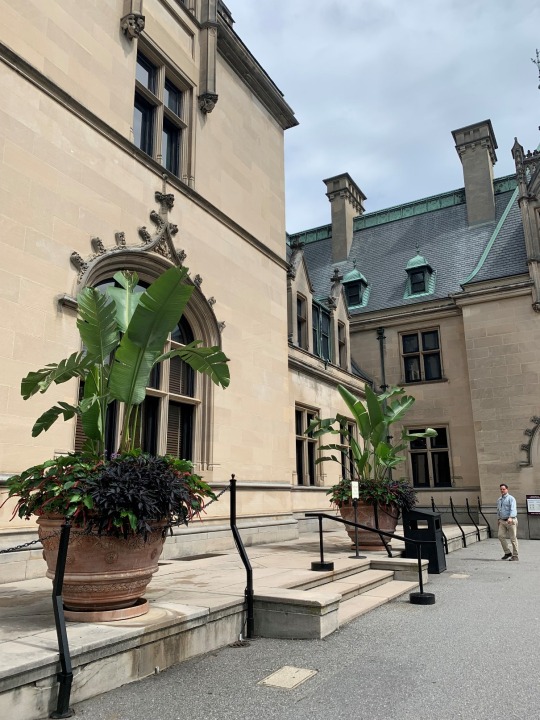
Construction of the house began in 1889. In order to facilitate such a large project, a woodworking factory and brick kiln, which produced 32,000 bricks a day, were built onsite. A three-mile railroad spur was constructed to bring materials to the building site. Construction on the main house required the labor of about 1,000 workers and 60 stonemasons. Vanderbilt made extensive trips overseas during construction to purchase decor. He returned to North Carolina with thousands of furnishings for his newly built home, including tapestries, hundreds of carpets, prints, linens, and decorative objects, dating from the 15th century to the late 19th century. Among the few American-made items were the more practical oak drop-front desk, rocking chairs, a walnut grand piano, bronze candlesticks, and a wicker wastebasket.
George Vanderbilt opened his opulent estate on Christmas Eve of 1895 to family and friends from across the country, who were encouraged to enjoy leisure and country pursuits. The Gilded Age mansion reportedly cost $5 million (today's equivalent of $180 million) to construct. Guests to the estate over the years included novelists Edith Wharton and Henry James, ambassadors Joseph Hodges Choate and Larz Anderson, and U.S. presidents. George married Edith Stuyvesant Dresser in 1898 in Paris, France. Their only child, Cornelia Stuyvesant Vanderbilt, was born at Biltmore in the Louis XV room in 1900, and grew up at the estate
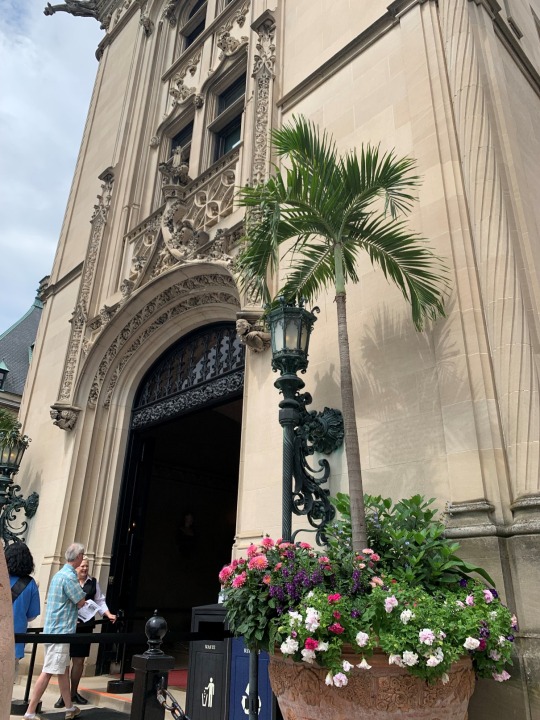
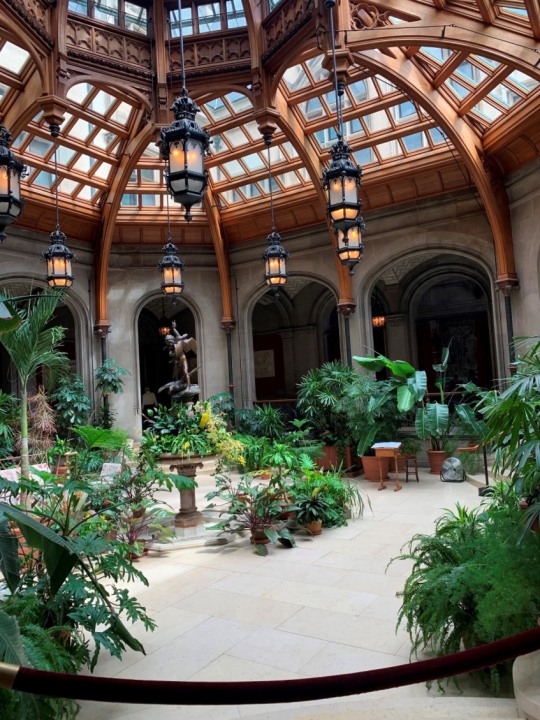
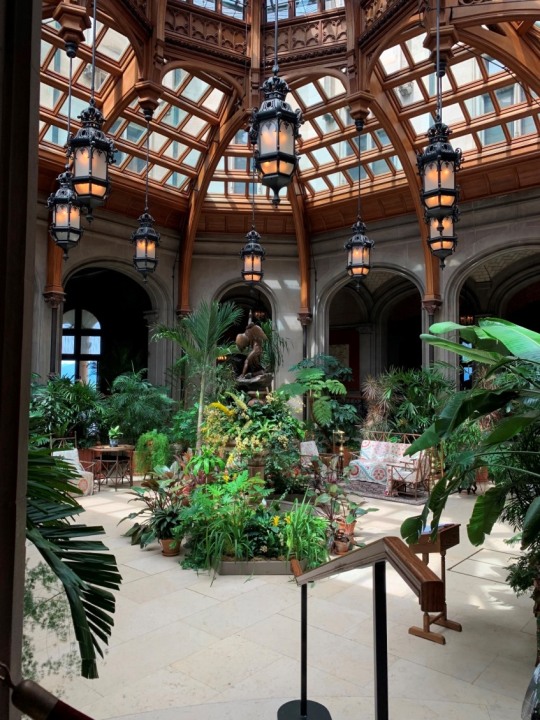
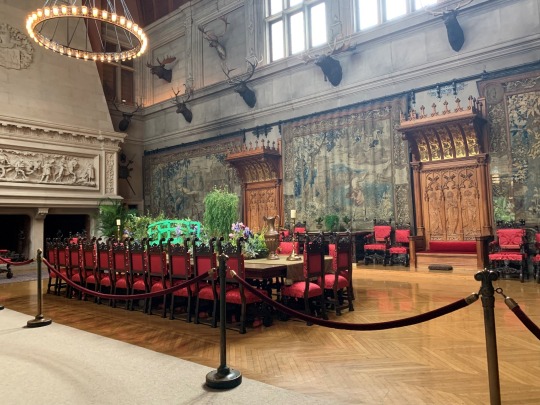
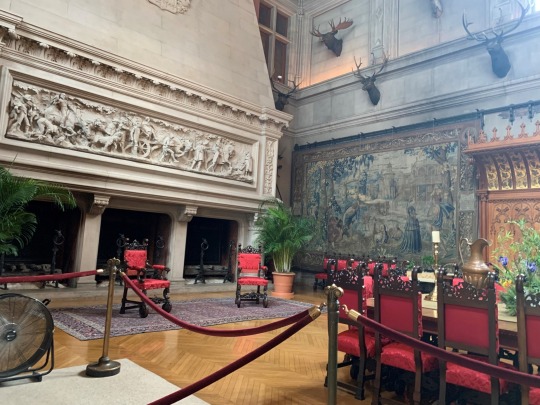
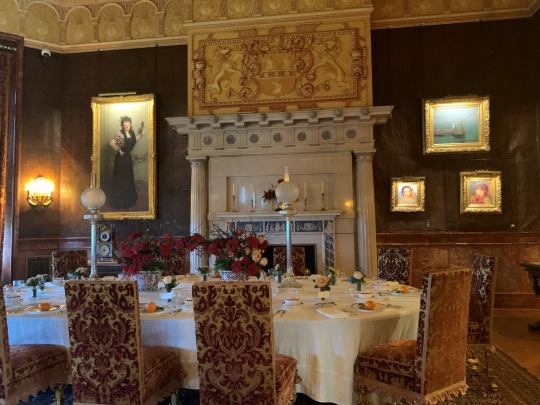
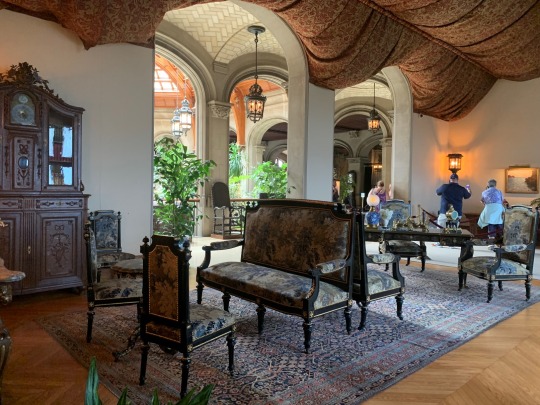
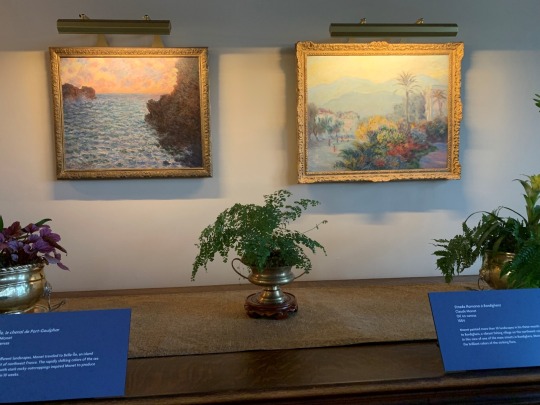
Stressed by Congressional passage of income tax and the expensive maintenance of the estate, Vanderbilt initiated the sale of 87,000 acres to the federal government. After Vanderbilt's unexpected death in 1914 of complications from an emergency appendectomy, his widow completed the sale. She carried out her late husband's wish that the land remain pristine, and that property became the nucleus of the Pisgah National Forest. Overwhelmed with running the large estate, Edith began consolidating her interests, selling Biltmore Estate Industries in 1917 and Biltmore Village in 1921. She intermittently occupied the house, living in an apartment created in the former Bachelors' Wing, until the marriage of her daughter Cornelia to John Francis Amherst Cecil in April 1924. The Cecils had two sons, who were born at Biltmore in the same room where their mother was born.
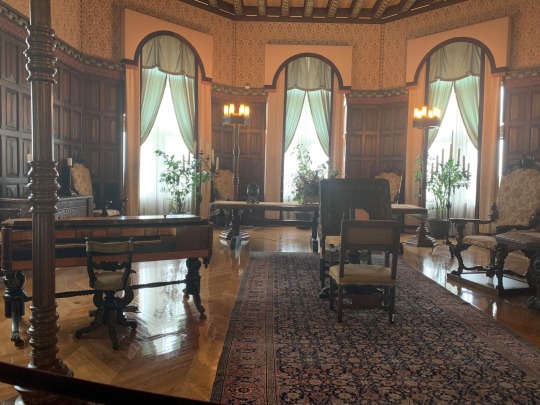
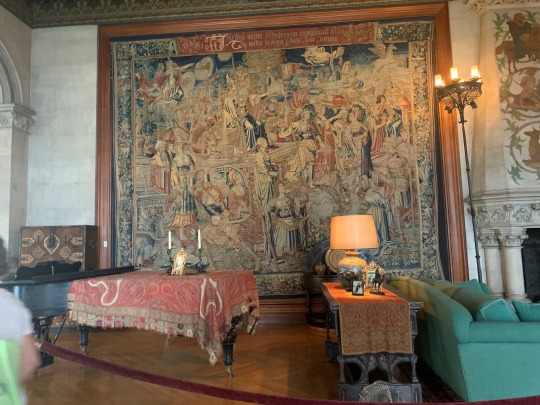
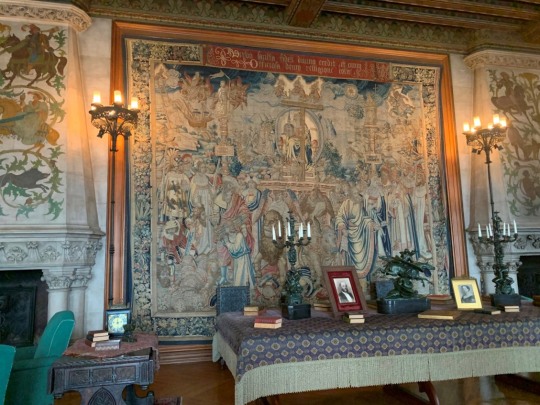
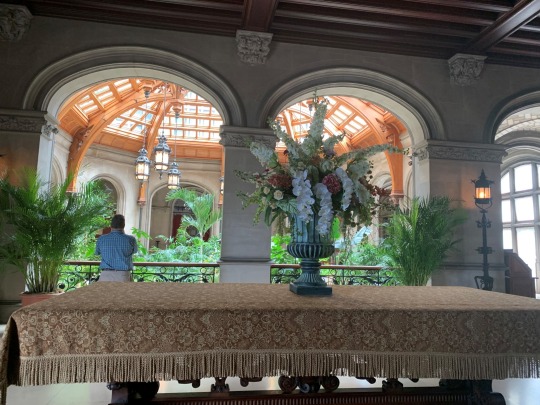
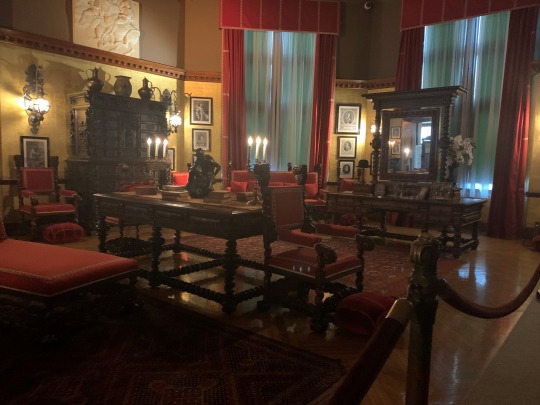
In an attempt to bolster the estate's finances during the Great Depression, Cornelia and her husband opened Biltmore to the public in March 1930 at the request of the City of Asheville, which hoped to revitalize the area with tou rism. Biltmore closed during World War II. In 1942, 62 paintings and 17 sculptures were moved to the estate by train from the National Gallery of Art in Washington, D.C. to protect them in the event of an attack on the United States. The Music Room on the first floor was never finished, so it was used for storage until 1944, when the possibility of an attack became more remote.
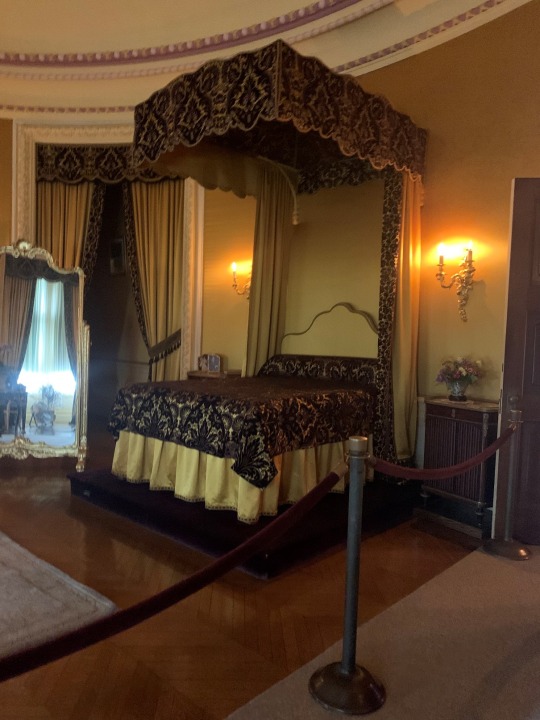

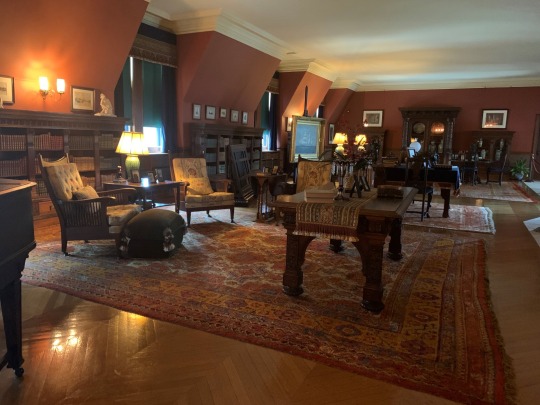
After the Cecils divorced in 1934, Cornelia left the estate never to return, but John Cecil maintained his residence in the Bachelors' Wing until his death in 1954. Their eldest son, George Henry Vanderbilt Cecil, occupied rooms in the wing until 1956. At that point Biltmore House ceased to be a family residence and was operated as a historic house museum.
Their younger son William A. V. Cecil, Sr. returned to the estate in the late 1950s and partnered with his brother to manage the estate's financial trouble. They worked to create the profitable and self-sustaining enterprise that their grandfather had envisioned. William Cecil inherited the estate upon the death of their mother, Cornelia, in 1976. His brother George Cecil inherited the more profitable dairy farm, which was spun off as Biltmore Farms.”
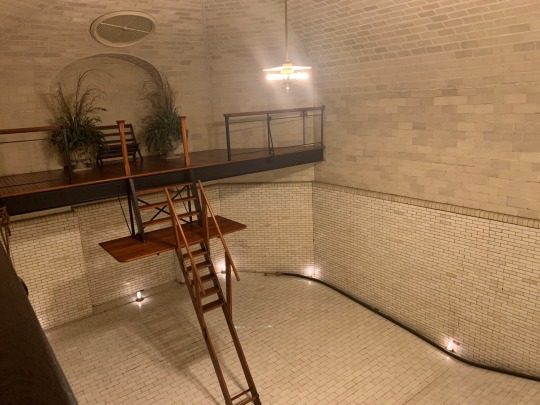



Down in the basement one of the most interesting things about the house museum was this display about the building of the mansion.




Some of the artwork on the walls, which was done by guests during a party, was amazing!



As a gardener, my favorite parts of the estate were the gardens and the greenhouse.










So, the question just begs to be asked. What made the Vanderbilt family so exceedingly RICH? Cornelius Vanderbilt came from a middle class family. His father was a farmer but also started a shipping business. Cornelius borrowed money from his father to start his first ventures in trading and ferrying, especially military troops and supplies. From that success he build an empire in the railroad industry. But was he TRULY a “self-made man” as so many industrialists were claimed to be? Looking it the history during those years there were many other factors working in their favor.

According to the Grunge history website:
“After all, this was the Industrial Revolution; it wasn't really kind to the everyday worker. Low wages and horrific working conditions were just part of the era (via Legends of America). And that was true of the railroads, too; according to The Atlantic, the normal wage for a man working on the railroad was a pitiful 75 cents a day. That's next to nothing, especially compared to the millions in the pocket of the Vanderbilt family. It also feels like it lines up with something that Vanderbilt's son, William Henry Vanderbilt, said to the press: "The public be damned." They only really cared about their stockholders and investments,
Basically, the government wasn't really on the side of the working class; they definitely sided with corporations. As History explains, the government worked to keep foreign competition out of the picture, giving industrialists the chance to create monopolies while facing few consequences. (Honestly, maybe that's also because plenty of politicians were easily bribed, gladly helping out their friends with deepest pockets, making sure legislation favored big business over the everyday worker).
And even where rampant corruption wasn't involved, there was ignorance. Encyclopedia.com says that Cornelius Vanderbilt wasn't above manipulating the stock market as he saw fit, he and other business owners selling stocks at inflated and unwarranted prices, simply because the government regulation wasn't there to tell them to stop.”
And they also paid LITTLE TO NO TAXES! Unfortunately, it sounds like not a lot has changed since the “Gilded Age”. Yes, there are some regulations and controls on industry and corporations, but most of them aren’t strong enough to prevent monopolies and mistreatment of employees. Just look at Amazon, Google and Meta (formerly Facebook). And they are the biggest, but there are MANY other multi-national corporations monopolizing industries and union-busting so that they can maximize their profits. That’s unbridled CAPITALISM for you, combined with political corruption, patriarchy, and GREED. The world has been plagued by this for centuries, if not millenia. If you don’t believe me, read “Sapiens: A Brief History of Humankind” by Yuval Noah Harari. It doesn’t have to be this way and many believe that a complete overhaul of the political and economic systems worldwide, as well as advancing feminism, would go a long way towards creating a truly egalitarian society. I’m among those people.

Bruce and I left North Carolina this afternoon to finish our vacation in Denver. We realized that if we contracted COVID we would be stuck at the Omni with NO ROOM SERVICE and no ability to leave to get food. Don’t ask me why that never occurred to us but seeing all those people not wearing masks was a wake up call and we hightailed it back to Colorado, where we checked into the Four Seasons Hotel, which has room service and is close enough to drive home at a moment’s notice.
2 notes
·
View notes
Text
A fun little whimsical tag ✨
Thanks to @onlineproblems for tagging me.
favorite movie? Everything Will be Okay
favorite book? The Picture of Dorian Gray by Oscar Wilde
favorite character? Sarah Lynn from Bojack Horseman. I love her so much one of my kitties is name after her.
favorite song? How do people actually have favorite songs. Theres literally a millennia if not more of music. Anyway probably “Ghost Love Score” by Nightwish or “.Goëtia” by Peter Gundry.
favorite color? Royal Blue. Because I am royalty.
favorite animal? Octopus
favorite scent? Lavender and Bergamot
favorite place? Any place filled with everlasting joy. A beach with happy friends, a town square, a living room filled with warmth and laughter.
favorite food? Pho is literally my comfort food.
favorite item of clothing? Big, obnoxious, artisan crafted hats usually modeled off of styles from the 1870s-1930s.
if you had the chance to make out with (or hug) anyone of your choosing, real or fictional, living or dead, who would it be? Harvey Guillen, Marilyn Monroe, Mae West, Vampira, and like a list of old film stars.
beach or forest? Beach
pastel or jewel tones? Jewel Tones
spring or autumn? Autumn. Halloween! Fun colored leaves! Pumpkins! Pumpkin spice! Fall spices! Chilly wind! Sweaters! Smores! And also fall colors look spectacular on me.
sci fi or fantasy? I like historical fiction with light fantasy touches so fantasy.
Ocean depths or outer space? Ocean. I like adventure stories.
if you were free of societal burdens like money, what would you choose to do? Become an eccentric artist with elegant gowns and finely crafted suits. A home with lavish furnishings like a gorgeous dining room and a ridiculously crafted bed probably done in the baroque style. I’d have wonderful dinner parties with delicious food, mouth watering libations, and possibly even live theatre or poetry readings. All of this is funded by a wealthy patron who allows me to do whatever weird art I want.
tagging @thelittlemermage, @memosminifridge, and @beansprean and anyone else who wants to do it!
2 notes
·
View notes
Text

This cute blue 1930 home with 1bd, 1ba, is a little pricey b/c it's a beach cottage on Tybee Island, GA. But, it's such a happy little house, I couldn't resist. Asking $550K. It's the smallest house on the island, so it's thought that it may have been a guard house, originally. It can also be a year round home.


Isn't this the cutest living room? It's just so cozy.


It doesn't say in the listing, but usually a vacation cottage is sold furnished. Since they took a closeup of this lovely bicycle pic, it suggests that it does come furnished.

Plus, there are closeups of various furniture pieces, too.


Pretty big galley kitchen and it also has a laundry area tucked in by the back door. I'm not seeing a dishwasher, though. I hate that.

The shower room is cute.

Very nice.


Sweet bedroom.

It's in the back of the house, off the kitchen. Check out the fridge right outside the door.

Nice large deck.

According to the description, the house can be expanded.

Hot tub down in the yard.

The deck has 2 stair cases and there's also a nice shed.

This is very nice. Love wicker.

The lot is pretty big. 4,739 sq ft.

The wicker set is on a small patio in front of the house and the firepit is off to the side.

Adorable picket fence with an arbor over the gate. Such an idyllic property. The sign has its name, "Sunburst Cottage."

There is definitely room to expand it.

It's about 4 blocks from the Atlantic Ocean.
https://www.zillow.com/homedetails/1514-2nd-Ave-Tybee-Island-GA-31328/14193587_zpid/
197 notes
·
View notes
Text
Art Deco for Home: A Timeless Design Style
Art Deco, originating in the 1920s and 1930s, remains a beloved design style known for its glamour, elegance, and bold geometry. Incorporating Art Deco for home interiors brings a unique blend of vintage charm and modern sophistication. This style is characterized by luxurious materials like marble, brass, and velvet, as well as striking geometric patterns, sleek lines, and rich color palettes.
To embrace Art Deco for home spaces, start with statement furniture pieces featuring curved edges, lacquered finishes, or metallic accents. Adding mirrors with sunburst or angular frames can amplify the opulent vibe while enhancing light in the room. Art Deco lighting, such as tiered chandeliers or sconces with frosted glass, further captures the era’s essence.
Textures and patterns play a key role in achieving this look. Consider using wallpapers with bold, symmetrical designs or soft furnishings in jewel tones like emerald green or deep sapphire. Don’t shy away from accessorizing with gold or silver metallics to complete the aesthetic.
Whether used in small touches or as a dominant theme, Art Deco for home design transforms interiors into timeless, elegant retreats that celebrate the glamour of a bygone era while staying relevant today.
0 notes
Text
Enhance Your Home with Mid Century Antiques
Mid century antiques, originating from the 1930s to the 1960s, are making a remarkable comeback in modern decor. These pieces are cherished for their unique retro aesthetic and nostalgic appeal, featuring materials like wood and wicker that add warmth and character to any space.
Unlike 17th and 18th-century antiques, which can feel more formal and ornate, mid century antiques offer a perfect balance between vintage charm and contemporary style. Their clean lines, functional design, and understated elegance allow them to blend seamlessly into modern interiors. Whether you're looking to furnish a minimalist living room or add a touch of history to a sleek, modern bedroom, mid century antiques can enhance your decor without overwhelming it.
The versatility of mid century antiques makes them a valuable addition to any home. From stylish chairs and elegant tables to unique lighting fixtures, these pieces can serve as focal points or complementary accents in a variety of settings. Their timeless design ensures they will remain fashionable and functional for years to come.
Incorporating mid century antiques into your home not only adds a distinctive look but also brings a piece of history into your living space. Each item tells a story and adds a layer of depth and character that modern furniture often lacks.
Explore the collection of mid century antiques at Mist Antiques to find pieces that resonate with your personal style and enhance your home decor. Embrace the blend of past and present, and create a living space that is both stylish and uniquely yours.
0 notes
Text
Brick c.1930 Furnished Affordable Tennessee Home Under $140K
$139,900 A brick, two-bedroom, two-bathroom affordable Tennessee home with 1, 556sqft. It comes fully furnished. With two kitchens, two HVAC units, two water heaters, it has the potential to be a two-family home. Also has a scenic, private backyard, but the interior is the real Wow factor with hardwood floors, fireplace, built-ins and vintage steel kitchen cabinetry. Realtor Comments An…
#1930#affordable Tennessee home#circa#old houses under 50k#Tennessee#Tennessee real estate#tn#TN real estate
0 notes
Text
THIS DAY IN GAY HISTORY
based on: The White Crane Institute's 'Gay Wisdom', Gay Birthdays, Gay For Today, Famous GLBT, glbt-Gay Encylopedia, Today in Gay History, Wikipedia, and more … October 25



51 AD – Rome: Titus Flavius Domitianus (51-96) was born in Rome. The Emperor is the first recorded case of a married man leaving his wife for a man, a mime named Paris. After a public outcry Titus killed Paris and went back to his wife. However, he continued his affairs with young men; his wife had him assassinated.


Claude Cahun Self-portrait
1894 – Born Lucy Renee Mathilde Schwob, Claude Cahun (d.1954) was a French artist, photographer and writer. Her work was both political and personal, and often played with the concepts of gender and sexuality.
She began making photographic self-portraits as early as 1912, when she was 18 years old, and continued taking images of herself through the 1930s.
Around 1919, she settled on the pseudonym Claude Cahun, intentionally selecting a sexually ambiguous name. During the early 20s, she settled in Paris with her life-long partner and stepsister Suzanne Malherbe. For the rest of their lives together, Cahun and Malherbe collaborated on various written works, sculptures, photomontages and collages. She published articles and novels, notably in the periodical "Mercure de France", and befriended Henri Michaux, Pierre Morhange and Robert Desnos.
Around 1922 she and Malherbe began holding artists' salons at their home. Among the regulars who would attend were artists Henri Michaux and André Breton and literary entrepreneurs Sylvia Beach and Adrienne Monnier. Cahun's work encompassed writing, photography, and theater. She is most remembered for her highly-staged self portraits and tableaux that incorporated the visual aesthetics of Surrealism
In 1937 Cahun and Malherbe settled in Jersey. Following the fall of France and the German occupation of Jersey and the other Channel Islands, they became active as resistance workers and propagandists. Fervently against war, the two worked extensively in producing anti-German fliers. The couple then dressed up and attended many German military events in Jersey, strategically placing them in soldier's pockets, on their chairs, etc. Also, fliers were inconspicuously crumpled up and thrown into cars and windows. In many ways, Cahun and Malherbe's resistance efforts were not only political but artistic actions, using their creative talents to manipulate and undermine the authority which they despised.
In 1944 they were arrested and sentenced to death, but the sentences were never carried out. However, Cahun's health never recovered from her treatment in jail, and she died in 1954. She is buried in St Brelade's Church with her partner Suzanne Malherbe.


1953 – Fenton Johnson, the award-winning author of "Crossing the River," "Scissors, Paper, Rock," "Geography of the Heart: A Memoir," and "Keeping Faith: A Skeptic's Journey" was born today. He was born in Kentucky and was the ninth out of nine children.
He dreamed of becoming the U.S. President when he was younger, but decided to become a writer after he enrolled in Stanford University. Johnson is Gay, and explores Gay issues in his work. His memoir "Geography of the Heart" deals with the loss of his partner Larry to AIDS.
He is currently an associate professor of creative writing at the University of Arizona and is working on a new novel The Man Who Loved Birds: A Novel. Johnson has received awards from the Wallace Stegner and James Michener Fellowships in Fiction and National Endowment for the Arts Fellowships in both fiction and creative nonfiction. He has also received a Kentucky Literary Award, two Lambda Literary Awards for best creative nonfiction, as well as the American Library Association Award for best Gay/Lesbian nonfiction.


Furnish with husband Elton John
1962 – David Furnish is a Canadian/British filmmaker, former advertising executive, and now a film director and producer most known for his documentary Elton John: Tantrums & Tiaras. He is the civil partner of British entertainer Elton John.
David Furnish was born in Scarborough, Ontario, Canada. Furnish graduated from the Sir John A. Macdonald Collegiate Institute in 1981 and received an Honours Business Administration undergraduate degree fromthe University of Western Ontario in 1985. He was recruited by the advertising agency Ogilvy & Mather, eventually transferred to the London, England, office and was appointed to their Board.
A mutual friend of Furnish and Elton John left a message for Furnish inviting him to a dinner party at John's house on October 30, 1993. Initially fearing that the dinner would be unpleasant, or that John would be boring, he instead found John to be interesting and engaging. Both were attracted to each other; John asked for his phone number and the two had a private dinner the following night.
Furnish resigned from his position in 1994 after finding it increasingly difficult to balance the position's demands with the demands of his new life with John. With a keen interest in film, Furnish enrolled in courses at the British Film Institute. He is currently co-chief of Rocket Pictures along with John. Furnish is a contributing editor for Tatler magazine and also is a regular columnist for Interview and GQ. Furnish currently serves on the board of the Elton John AIDS Foundation, attending fundraisers and other events in support of that cause.
Furnish was proposed to by John in May 2005 at a dinner party with friends and family at one of their homes in Old Windsor. Furnish and John entered into a civil partnership on December 21, 2005, the first day that civil partnerships could be performed in England, in the town of Windsor, Berkshire. Their son Zachary Jackson Levon Furnish-John was born December 25, 2010 in California via a surrogate. Zachary weighed 7 pounds, 15 ounces.


Raphael Simon
1967 – Pseudonymous Bosch is the pen name of Raphael Simon, the author of The Secret Series and The Bad Books series of fiction books, as well as three stand-alone titles. He has released 12 books, each widely read.
Raphael Simon was born in Los Angeles County, California. His brother, Jesse, is a visual artist.
Simon came out as homosexual when he was 20 years old. He currently lives in Pasadena, California with his partner, Phillip de Leon. They have twin girls, the biological offspring of Simon, who were born around August 2008.
Bosch had long been suspected to be the author Raphael Simon, although Bosch disputed this until he "came out" as Simon in a May 8, 2016, editorial in The New York Times.

Pseudonymous Bosch
The pseudonym plays off that of the artist Hieronymus Bosch. It also may play off the fictional Los Angeles detective, Hieronymous "Harry" Bosch, also named after the artist, created by the author Michael Connelly, and who has appeared in several of his novels starting in 1992.Bosch published Write This Book!, a do it yourself book; he calls it "a book that readers will write for me". Bosch elaborated in an interview with Wired stating that "it is a kind of half-written, guided mystery. Parts of it are going to be multiple choice, choose-your-own adventure, parts of it will be more like Mad Libs, and some silly stuff".
On May 14, 2019, Bosch published The Unbelievable Oliver and the Four Jokers, with illustrations by Shane Pangburn. The book is about an eight-year-old boy who longs to be a professional magician. A followup, The Unbelievable Oliver and the Sawed-in-Half Dads, was released on May 12, 2020.
In 2021, Bosch published The Anti-Book, his first book under his real name Raphael Simon.


1997 – Tyler Alvarez is an American actor, known for his roles as Diego Rueda in Nickelodeon's teen sitcom Every Witch Way and Peter Maldonado in Netflix's mockumentary series American Vandal.
Alvarez was born in New York City, to a first generation Cuban American father, and a fourth generation Puerto Rican American mother. His father works for the Drug Enforcement Administration and his mother works as a nurse administrator for a private hospital. Alvarez's parents divorced when he was a child and both subsequently remarried.
Alvarez's first professional acting job was in a Totino's pizza rolls commercial. In 2014, he began starring as Diego Rueda, a human with magical powers, in Nickelodeon's teen sitcom Every Witch Way. The following year, Alvarez began portraying Benny Mendoza, the eldest son of Litchfield inmate Gloria Mendoza, in Netflix's comedy-drama series Orange Is the New Black.
In 2017, he began playing the lead role of Peter Maldonado in Netflix's true crime mockumentary series American Vandal. He returned for the second season which aired in 2018. The series has since been cancelled by Netflix.
Tyler Alvarez also appeared in the YouTube satirical miniseries ¡Me Llamo Alma!, starring as Miguel.
In 2020, Alvarez made his off-Broadway debut with the Roundabout Theatre Company's play 72 Miles to Go. The production closed prematurely due to the COVID-19 pandemic.
On June 11, 2021, Alvarez publicly came out as gay on social media.


0 notes